#munciememories
Explore tagged Tumblr posts
Text
Down The Rabbit Hole








The promise of factory jobs originally led many people to the town of Muncie. Places of business shifted and changed throughout time. Businesses flourished and businesses dissolved. The Village is currently home to ‘White Rabbit Bookstore’. This building could appear as though it has always been home to thousands of books, but that was not always the [book]case.
White Rabbit Bookstore has been around for thirty years, but the building has been there since the twenties. It was originally a home. In the fifties it was a men’s clothing shop. In the sixties, it was home to a cookie and coffee shop. Later, it became a gift shop in the seventies. After that, a skateboard shop. The last business the building inhabited before becoming the current bookstore, was a portrait studio.
The Pizza place directly next to White Rabbit, ‘Greeks’ used to be a butcher shop and grocery store. According to legend, a butcher was working late one night and accidentally cut himself and bled to death in the store. It is said people have spotted his ghost in both White Rabbit and Greeks. Specifically, in the waitressing station.
The store itself is overflowing with books encasing every nook and cranny. The staircase leading up to the upstairs portion was introduced to the store in the fifties during a major remodel. It came from a factory. The previous staircase stretched into Greeks.
Currently, science fiction fantasy and classic books are their best sellers. They have many methods of collecting great additions to their store. They attend rummage sales, flea markets, and often times people will bring their collectables to the store itself.
#whiterabbitbookstore#munciememories#muncie#bookstore#reading#books#book#read#brainfood#light#photography#lightroom#cozy#summer#inside#natural light
11 notes
·
View notes
Photo

Good chance to see our #Muncie map AND participate in a cool project, go see @munciememories at @minnetrista tonight! #Repost @plyspace with @get_repost ・・・ Memories! From the corners of my mind! Come check out the @munciememories Inaugural Interview Booth! Rocking recordings at @minnetrista until 10 pm! https://ift.tt/30ix75P
0 notes
Text
Strike!

Clancy’s Village Bowl is one of Muncie’s finest weekend hangout spots. They host birthday parties, cosmic bowling, college nights, and league bowling. Cosmic bowling is a special feature that happens every Friday and Saturday night in which the alley turns on black lights and the internal designs glow to create an exciting atmosphere. College nights occurs every Sunday from 10pm to midnight and is only $15 per person with shoes included! All ages can be sure to find entertainment here. Their facility includes 56 bowling lanes, 12 VIP bar side lanes, snack bar, full service bar, and a banquet room. They also feature a colorful arcade full of fun games.

Clancy’s has a retro vibe that throws back into the 80s’ and reminds you of simpler days. During the Spring and Summer seasons, live music is featured during your bowling experience. No matter the day, bowling is an inclusive sport that is fun for all ranges of athletic ability! Whether you’re playing a few games with friends or looking for a fun place for your child’s birthday party, Clancy’s can guarantee a cheap and enjoyable experience.
https://www.clancysvillagebowl.com/
5 notes
·
View notes
Text
House Shows Over House Parties
Welcome to Ball State University, a college where live-music shows are more appreciated than fraternity parties. Here in Muncie, the Ball State students embrace the local music scene by visiting house shows and maybe even starting their own band. The diverse music culture allows many students to find friends, bands, and places to be themselves. One of the bands, Honey, Be Well, has experienced success here in Muncie and across the state of Indiana.
The local music scene in Muncie has been growing steadily for the past two years. Honey, Be Well, originally 4-Piece Nugget, is one of the many local bands here in Muncie. The alternative rock/emo band released their first EP, These Emo kids and Their Damn Polaroids, in the spring of 2018 and are about to start recording their next album any day now. Honey, Be Well consists of four members, Noah McCormick, the lead singer and guitarist, Jay Olt, also on guitar, Justin Vanover on bass, and David Barthel on drums. Although the band originated in Muncie, none of the members are actually from there. Being Ball State students the band was able to network themselves allowing them to become one of the leading bands here in Muncie. The lead singer, Noah McCormick says the band loves playing with other local bands such as “Charmer, Tell the Wall, Bogues, Arcadia Grey, Dana Skully, and Perceptions”. Honey, Be Well loves to play in Muncie and Indianapolis because of their local feeling but their favorite out-of-state spot is in Grand Rapids, Michigan! With over 2,000 instagram followers, and two tours under their belt the band has many achievements, and more to come!

Noah McCormick (left) and Jay Olt (right) playing at a house show in downtown Indy
Muncie’s steadily growing student music scene doesn’t stop with local student bands. Many students, who aren’t in bands, provide locations for shows for the bands to play in. The Sauna, a venue run by Clay Easton, Max Denari, Michael Cottone as well as a few others is a fan favorite for the audience and the bands as well. The Sauna is a detached garage, aptly named for the heat that gets trapped in it during shows. The Sauna boys have done a fantastic job networking themselves in order to find more bands who would be interested in playing at their location. They have created social media accounts, as well as bought stickers to give out to people during the house shows! There are many other locations in Muncie including the Bat Cave which was another popular location before the resident graduated and moved away. The Bat Cave was especially popular because the basement provided a nice separation between the show and the party. There was also an adorable dog named Graham, and his nails were always painted, so that was a bonus.

David Barthel on drums
To add to the many bands and locations to play in, there is also a student run production company titled Lame Brain Production organized by Brandon Gick, Ethan Smith, Michael Hedrick, and Sam Kubiak. According to their website Lame Brain Productions “is a small team of like minded individuals looking to better the music community in Indiana by providing local, regional, and nationally touring acts with a place to play. Currently based in Muncie, IN, Lame Brian is looking to expand and grow becoming a more solidified business in the coming years”. Lame Brain helps local musicians by providing a pathway to find local venues to play shows in. Everyone involved is extremely passionate about local music and has already contributed more to the Muncie music scene than anticipated.

Honey, Be Well playing at The Sauna. Jay olt on guitar (left), Noah McCormick singing and guitar (middle), and Justin Vanover on bass (right).
Muncie’s local Music scene continues to grow and hopefully future students will take on the rolls current students have created. Everyone involved with developing Muncie’s music scene as contributed to expanding the community and broadening the horizons of many young college students.
Honey Be Well’s social media:
Instagram: @honeybewellband
twitter: @honeybewellband
The Sauna social media:
Instagram: thesaunavenue
twitter: @thesaunavenue
Lame Brain Productions:
Instagram: @_lame_brain_productions_
2 notes
·
View notes
Text
Introducing Muncie Memories!
Welcome to Muncie Memories! This is a collaborative storytelling project that invites the residents of Muncie to share their experiences, memories, and stories of the place they call home.
We are thrilled that you’ve found us! we can’t wait to meet you! If you’re here, that must mean that you’re either
a.) really into learning about Muncie or b.) really knowledgeable about Muncie already!
If a.), then join us on our research quest! If b.), then we want to hear all your stories and be filled with all of your knowledge!
This is a collaborative project; we can’t do this without all of you! (And, really, we couldn’t do this without PlySpace, since it’s a project funded and presented by them!)
First things first. Meet the Team!
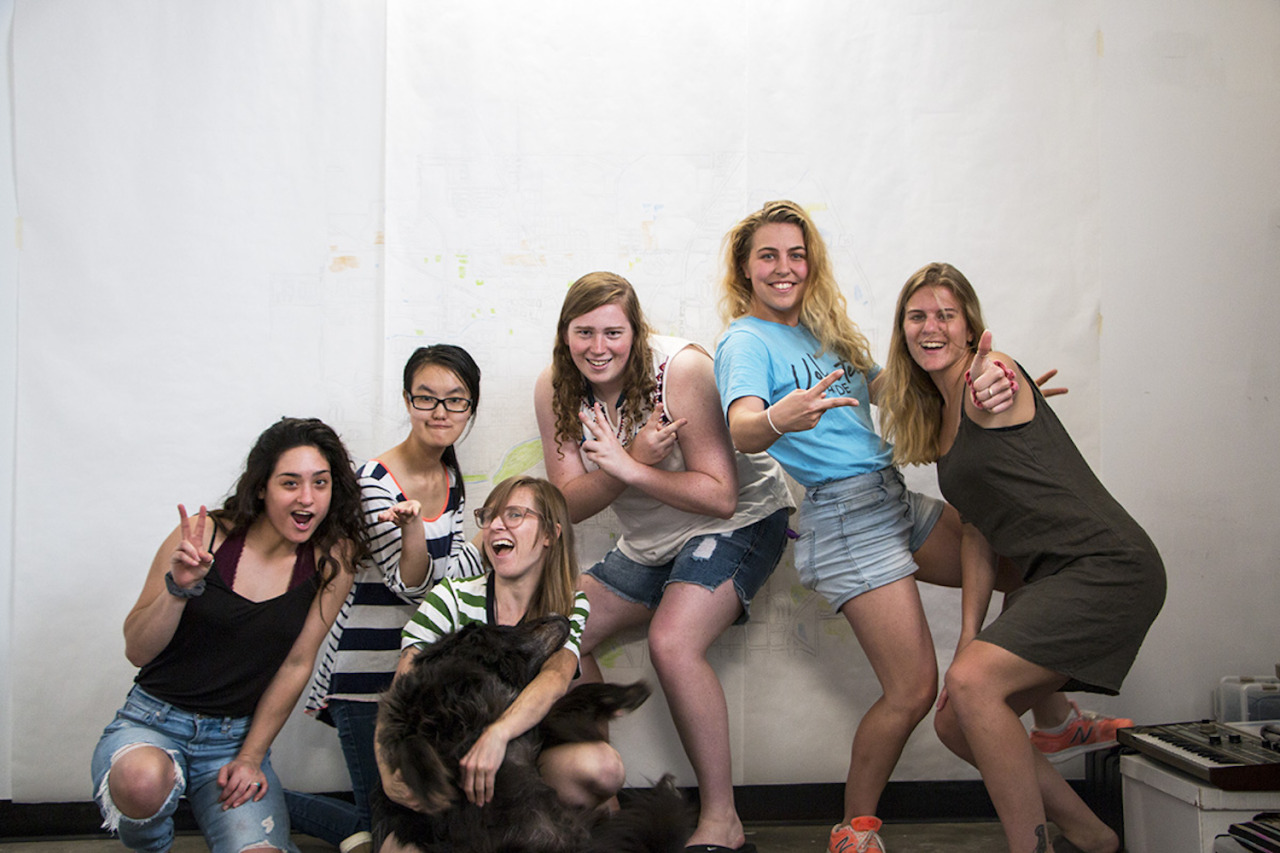
Such a solid group, don’t ya think?
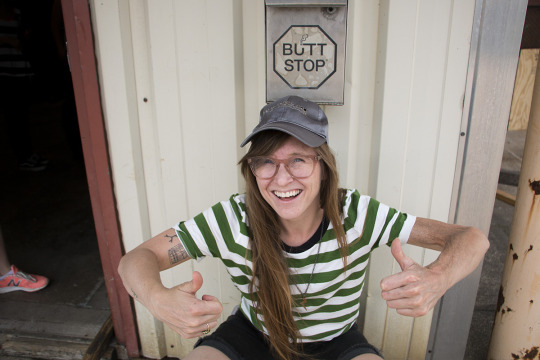
Meredith Kooi is PlySpace’s Summer 2019 Resident Fellow. Chicago proper born, Chicago burb bred, Meredith has been living in Atlanta for the past 8 years working on community-based projects, producing installations, curating exhibitions, writing art criticism, making music, and otherwise moonlighting as a PhD candidate at Emory University. She’s here in Muncie and very keen on getting to know y’all.
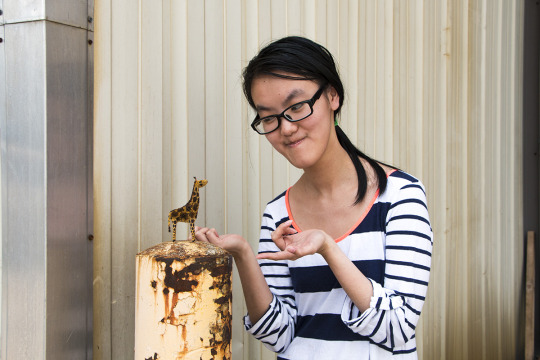
Ellie Phan is a graphic designer who also minors in computer science. Her goal in life is to design promotional products and advertisements for the food, cultural, and advertisement industries. She is a big-time foodie and she loves to travel to different places to have new food experiences. When she is not designing, you can find her hanging out at her usual restaurant or reading a novel in a small corner.
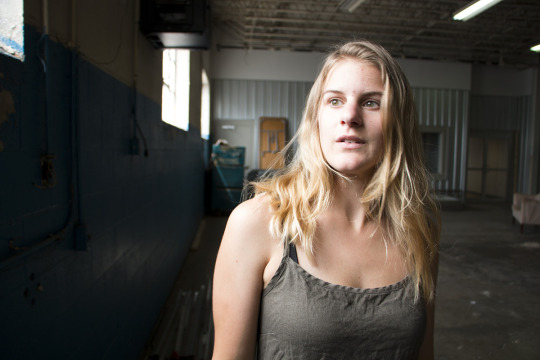
Jenna Mesker is a photography and intermedia major who loves coffee, windows, and vintage toys. In her free time, she loves going to concerts, riding her bike, and loving her dog. She thinks the banjo is the best instrument (even though no one else probably thinks that) and that sitting in her backyard listening to bluegrass music in the summer is the best activity. Jenna is currently splitting her time between Indianapolis and Muncie, but looks forward to interacting with the community in Muncie as much as possible!

Kai Cohen is a photography and intermedia major. She is passionate about music and art. She is constantly in pursuit of The Beatles bootlegs and photographs. Kai strives to capture random genuine happenstance through photography and video. Kai hopes to see you behind her lens soon!
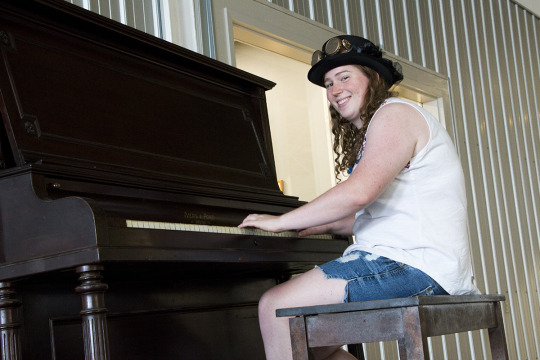
Katie Strader is a Senior at Ball State studying graphic design. She is a quirky individual that enjoys to nerd out. Her love for playing the viola followed her to college after high school, leading her to join the Ball State Campus Orchestra. Over the summer, she plans to dabble in oil painting and creating new works of art after falling in love with it during her painting class this past fall.
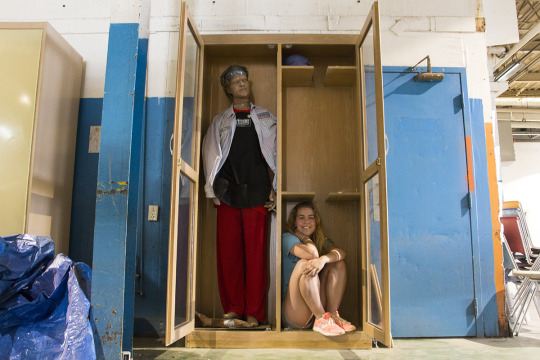
Kitty Taylor is a local sculpture artist who focuses on women’s issues. Born in Evansville, IN, Kitty is no stranger to rural living, city living, and the weirder parts of life. A recent graduate of Ball State, she looks forward to learning more about her new home and is excited to meet the mocals.

Belle, otherwise known affectionately as Grandma Belle, is Meredith’s longtime companion. She provides much needed research, development, and production support. She enjoys snacks and belly rubs.
1 note
·
View note
Text
The Jolly Roger

It is not uncommon to find house parties and volunteer groups in Muncie. Especially near Ball State Campus. There, you’ll find a hidden treasure that shares both identities. That place is known as The Jolly Roger. Being the constant host of Punk shows, expressive arts, and food donation, The Jolly Roger is home to a crew of individuals who, while sometimes transient, are charming and welcoming. Many of these members are Muncie natives who understand the harder times in life. From recovering addicts to anarchists they strive to help those in need out of compassion and understanding. The shared ideology of the crew seems to be give what you can to the community so all can strive. They can be seen contemplating the meaning of life during the day on their porch petting their cats or running the Food Not Bombs Program out of their living room when shows are not going on. Active on Facebook their description says:
“The Jolly Roger is a collective living space, as well as a budding social center and DIY venue. It is a place to gather and make friends, and to share food, art, music, and dreams of a better tomorrow.
Welcome aboard!” - https://www.facebook.com/JollyRogerMuncie/
A haven for punks, artists, and the struggling student, The Jolly Roger is a hidden treasure extending hope to each passerby.
1 note
·
View note
Text
Field Walk at McCulloch Park
Introduction - Meredith
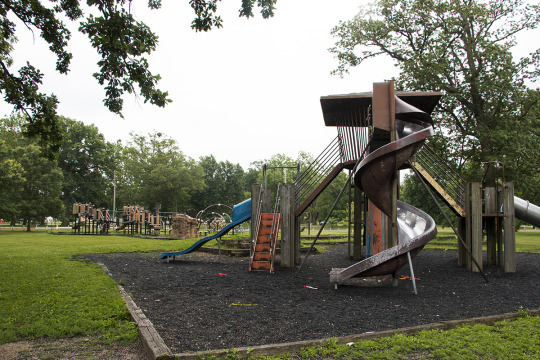
Last Wednesday, July 10th, part of the Muncie Memories team (Ellie, Katie, Kitty, and Meredith) went on a fielwalk in McCulloch Park. Starting in the south end at the playground, we worked our way up to the north end to Centennial Ave and then back south again to the statue of George Foulke McCulloch, who the park was named after.

McCulloch, born in Lancaster, OH in 1855 moved to Muncie with his parents at the age of one and went on to found the Muncie Star, the Indianapolis Star, and the Terre Haute Star. In 1901. McCulloch moved away from Muncie and decided to donate 83 acres of his land to the city, entrusting it for the free use by its citizens.
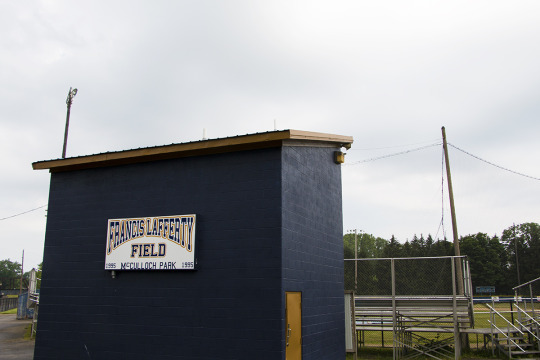
Neighboring McCulloch Park on the east side of Doctor MLK Blvd is the Whitely Community, a historically black neighborhood, which was originally founded as its own city, Whitely Town, but William Needham Whitely from Ohio. Prior to McCulloch Park being a park, the land had been the site of the Whitely Harvesting Machine Company, but it had burned to the ground in 1894. Someone told me that part of the plant used to be where the baseball diamond now lives, but I also read that the company used to be where East Central Recycling is now. (Also significant, but adjacent to this discussion, is the controversy that surrounded the renaming of the street that is now Doctor MLK Blvd.)

During the 1920s, the park was segregated, with KKK meetings and cross burnings even taking place in the park. The south side of the park, which had, and still continues to have, the majority of the park’s amenities including the baseball diamond, bear pit, safety town, basketball court, sledding hill, playground, and more, was reserved for whites. The north side of the park was for blacks.

But the north side provided other unexpected moments of discovery. A couple shelters for sitting and gathering. Disc golf tee offs. An almost secret path to those less observant. The fire station where Hurley Goodall got his start as a firefighter. (A more thorough post for another day!)
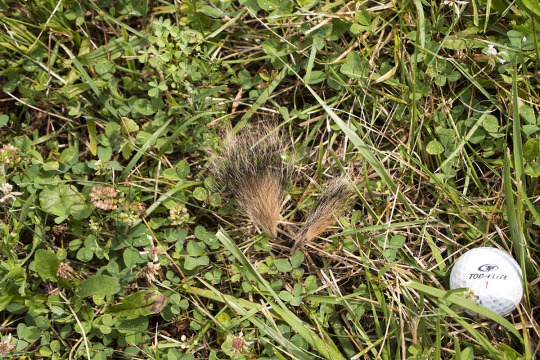
Nature. A growing orchard. A buckeye tree. Not just for Ohio.

It’s evident that there is still a certain kind of segregation going on amongst parks. If we put McCulloch Park in comparison to the other park / green space we’ve conducted a fieldwalk in previously -- Minnetrista -- then, well, you’re looking at two entirely disparate entities. The bank account of one cannot be judged by the other. Experiencing these parks in their nuances and layers, brings up and renders palpable the ways in which we prioritize certain things over others, or certain places over other places.
But, no matter where we find ourselves, there we are. And, here are some thoughts and experiences from Katie, Kitty, and Ellie about the time we spent in McCulloch Park.
Two Sides of the Park - Katie


McCulloch Park is located primely in the Whitely community and surrounded by the hustle and bustle of the town activity. What’s interesting about the park is that it’s divided into two parts due to a road running through the middle. When visiting the two different sides, it was like we were exploring two different parks.
We began our fieldwalk at the south section of McCulloch Park and was pleasantly surprised at what we found. You can tell that most community gatherings happened on this side of the park. There was a variety of playground equipment that any kid would have a blast climbing all over. A little further to the left past the Go-kart track, lies a couple of basketball courts where we were entertained by the spirited game that was going. The park itself was filled with pastel colors, adding to the beauty of the place. It was disappointed that their Safety Town wasn’t up and running when we were there, but it was still interesting to see the layout of the fake city.


It was a surprise when we traveled to the other side of the park at how different the atmosphere was compared to the other. There was more of a quiet and peaceful feeling to the north side of the park. Nature was more predominate and there seemed to a lack of park structures when we were strolling through. It felt like this side of the park was more geared towards wildlife instead of the community aspects of a park-like the other side. Despite the strong presence of nature, it almost felt empty with the noticeable man-made structures being a shelter and scattered Frisbee Golf baskets throughout.
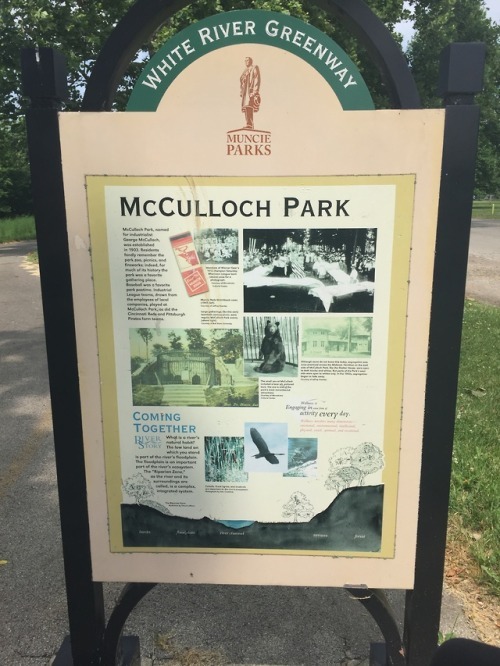
Though the two sides were quite different, it was interesting seeing how each side seemed to represent one of the main aspects that make up a park, community, and nature.
Kitty’s Playdate
I’ve run through McCulloch Park plenty of times with the Ball State Cross Country team. However, this time, since we were walking at a much more leisurely pace, I was able to take in the scenery and did not have to worry about territorial gophers. When we arrived, I noticed a small girl and her mother at the playground. The girl watched our group walk through and decided she needed help on the merry-go-round. What could have been only about five minutes of pushing her on the merry-go-round quickly turned into 20 minutes of playing on the playground. This six year only was quick to point out all of the infrastructure problems of the older playground equipment. This included rusted metal that was chained together to allow the structure to stay put. I found this interesting that someone so young had already learned what the degradation of buildings looks like on sight. However, this didn’t deter her from enjoying her environment. She said that the new equipment was more fun but she was still excited to slide down the older slides. As she played, I looked around me at the crumbling bases and buildings of the park. It made me think about how old the park actually was. Eventually the playdate ended and I moved on with the group.

Further on, I came to a shelter. A lot of it either had racist graffiti on it or seemed to be slowly falling apart. Those features told me much about some of the characters who come to the park. It brought me a little bit of sadness because it’s such a beautiful area and it’s one of Muncie’s hidden treasures. But, maybe I’m beginning to understand how this park came to be in this state.
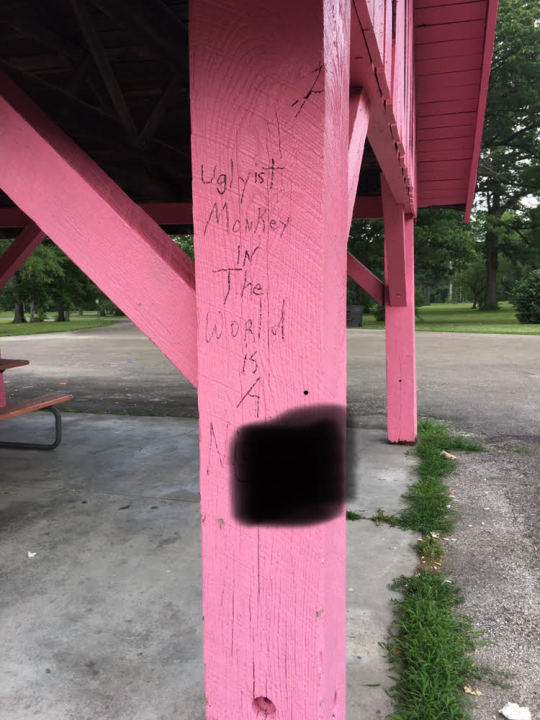
While I only know tidbits of Muncie history, I do know that the history of McCulloch Park wasn’t and isn’t always considered the safest. I’ve asked locals why that is, only to learn of dangers, such as pedophiles, that brought the park to an uncomfortable reputation. Growing up in a small town, I understand the importance of parks and hope that BSU students and locals come together to restore McCulloch Park in the future. Thank you for the beautiful park Muncie!

The markings with stories. - Ellie
No matter where you go, there will be some markings with stories that are left behind by people. There are so many stories that can be found through a simple walk to a park. On our fieldwalk through McCulloch Park, there were several markings with stories spotted throughout the trail. The markings were either hidden or easy to find. For example, I found a heart-shaped tag on the stone ground in a playground. I saw a half of caution tape, several broken pregnancy tests, a crumbled tie-dyed shirt, a forgotten black hoodie, weird graffiti, a crafty golden letter “A” on a green leaf, small carvings of phrases and names, a green Pringle can, and funky latex gloves. No matter how I found or spotted these markings, there is some part of me that is curious about the backstory of how the marking was left there.

The human mind will immediately try to make up stories or scenarios as to why these markings were left here. For an example, my mind made up scenarios for a heart-shaped tag I found. Perhaps someone proposing to their significant other with a stuff animal, or it was attached to a stuffed bear gifted to a child. Another case where my mind made up another story was for the broken pregnancy tests. One scenario was that someone told their partner that they were pregnant, and the reaction was negative, so they threw it on the ground. Or the pregnancy tests were actually from a happy event like a baby shower. Who knows what really happened with each of these markings?! All I know is that there are some funny or serious stories carried within each marking I found and recorded throughout the walk at McCulloch Park.

With that, I challenge Muncie Residents to go to McCulloch Park and send me pictures of what you can find at [email protected]! Remember not to touch what you see without protective gloves.
#muncie#plyspace#munciememories#mccullochpark#whitely#parks#community#safetytown#playground markings#munciearts
1 note
·
View note
Text
Muncie’s Moth Danner
Muncie’s art scene is full of influential characters and events. One of the more well-known residents is a woman known by the name Moth Danner. A 7th generation native, Moth has seen Muncie go through its changes. Growing up in a bookstore fueled her with a desire for literature and art. In one video interview, she said that growing up she would grab any book at arm’s reach and read. Her favorite? The play A Midsummer Night's Dream by William Shakespeare. She was enamored by Titania’s fairy court which would become useful later in life. Coming of age in Muncie’s 80’s punk culture, she was part of the alternative scene. When she wasn’t finding hidden shows in abandoned buildings she was experimenting with self-image. These people skills led to her professional life as an IU graduate with a degree in Psychology and an ordained priest.

Moth and her mother Susan
She gave herself the name Moth while doing performance art in New York City to allow herself to flee in secrecy from the police during shows. The idea was struck when a fellow artist, friend, and Shakespeare lover shared a show with Moth. They chose names from the fairies in Titania’s court which included Moth, Cobweb, Peaseblossom, and Mustardseed. Cobweb was too Goth so Moth chose Moth. The name stuck and has followed her ever since.
Like Titania, Moth knows where her court stands. Her punk friends aka freaks were acquired due to the alternative and body mod scene of the punk groups of Muncie. Regardless of which scene she is in, Moth is a welcoming face in Muncie. This is due to her grassroots ideals and efforts to encourage small businesses and the arts.
She is a board member on the Muncie Arts and Culture Council; creator of the Muncie Makers Market, Sunday Stitch n’ Bitch, Cuplet poetry night; current head of YART; and previous owner of Dominion nightclub and vintage clothing store Savoy; and co-owner of Danner’s Bookstore (sadly, all of these shops have been closed). Alongside Minnetrista’s Farmers Market on Saturdays Moth’s Muncie Makers Market has helped weave together the community. She got the idea for a makers market when she and her mother began making and selling pies in a nearby town’s market. Moth saw an opportunity for something Muncie needed.
Only homegrown sellers and handmade wares are allowed. A similar concept came with YART, a program Moth inherited from Ball State Art students that started in the 1970′s, a twice a year massive maker’s market focused on selling local art.
Whether she is creating a space for a vent session at The Cup’s Bitch n’ Stitch or seen orchestrating another great happening, Moth combines the alternative scene with a grassroots ethos to shine another great light on Muncie.
Organizations Moth is a part of:
Muncie Makers Market- https://www.facebook.com/groups/1627047027524961/
YART- https://muncieyart.tumblr.com/
Muncie Arts and Culture Council- http://munciearts.org/
Stitch n Bitch- https://www.facebook.com/groups/1472977992921700/
Cuplet- Every 4th Sunday of Every month at The Cup
Sources:
https://www.youtube.com/watch?v=NIp-pBih8ag
https://www.thestarpress.com/story/news/2017/05/09/muncie-local-makes-market-reality/97890266/
https://www.bookweb.org/news/danners-books-muncies-independent-bookstore
https://munciearts.org/2019-board-of-directors-elections/
#munciememories#munciemakersmarket#muncie#mothdanner#moth#goth#altnerative scene#punk#munciearts#art#TheCuplet#YART#Stitchandbitch
0 notes
Text
A trip down South Hoyt Avenue
written by: Ellie
Let’s take a trip down memory lane, or in this case, South Hoyt Avenue. South Hoyt Avenue is a street name of one of the roads in Muncie, Indiana. The street starts at Muncie Fireman’s Park and goes down south until you reach Tomlinson Cemetery. It takes 7 minutes to drive the length of South Hoyt Avenue (from Muncie Fireman’s Park to Tomlinson Cemetery) and 1 hour 10 minutes walking time.

As you travel down the street either by car or on foot, you will see houses and business. Some prominent businesses you will spot on your trip are:
Habitat for Humanity
Irving Materials
Arrowhead Plastic Engineering-Fiberglass Plant
McDonald’s Kennel
Comcast Service Center
Attlin Constructions
Henkel
Midwest Metal
Applied Industrial Technologies
Camtool
Eagle Battery
Kendon
Etc..
As you go down the street, you can see that the surrounding look a bit run-down. In your observations, you can perceive that there are more buildings and houses along the street than trees. Although, around 2529 South Hoyt Ave, you will notice a field of soybeans next to a gas station. The further you go down the street the heavier the traffic gets. You also begin to see that there are more businesses ran out of homes than actual business buildings. As you approach the south part of the street you start to spot more trees than buildings and more fields of crops the farther you get. Eventually, you make it to the Tomlinson Cemetery.
Once you come home, you decide to do more research on South Hoyt Avenue. You found out that there are three old businesses that were created on the street since before you were born. The three businesses are Sam Gold Store, Kirby Wood Lumber Company, and Arrowhead Plastic Engineering, Inc.
You can’t find a lot of information on Sam Gold Store except the blue prints for the building. The first images are commercial building working drawings from the 1930s. The original year the drawing was made in 1937. It was located near the corner of 12th street and Hoyt Avenue in Muncie. The architect of the buildings was Carl Wave Garrard and J.T. Keely.



The below image is the storefront working drawing from the 1920s. The exact year the original was made in is 1921. The address was 109 W Main St. as it moves location from the Hoyt location. The architect of the buildings was Cuno Kibele and Carl Wave Garrard.

The second business you found, was the Kirby Wood Lumber Company. In the collection at Ball State, you found an office working drawings from 1918. The building was located southwest corner of S. Liberty St. and Hoyt Avenue. The architect of the building is Cuno Kibele. The drawing includes plans, elevations, and other details.




Kirby Lumber Co. was first built in spring 1899 by two brothers, Thomas H. and John M. Kirby. The Brothers were later joined by Julius E. Wood, who brought in a flourishing sawmill property. The company later changed its name to Kirby-Wood Lumber Company after Julius E. Wood joined the Brothers. After Thomas H. Kirby died in 1911, Robert D. Barnes took over the company as the secretary-treasurer until the closing in the late 1960s.
Fun Facts: There is a statue of Paul Bunyan in front of the Timbers Lounge dated from the mid-1960s. It was created by Art Forms to advertise Kirby-Wood Lumber Company.

The building is no longer in Muncie, Indiana but the statue of Paul Bunyan is still in town.

The last business is Arrowhead Plastic Engineering, Inc., a fiberglass and composite molding facility. The company was founded in March of 1972 with 1600 square foot. As the company grew, the 1600 square feet became 4000 square feet in 1972. Then, in 1977, the company grew to 35,000 square feet and moved to the south of side of Muncie. The building still stands until this day at 2902 S Hoyt Ave.

Hopefully, you enjoy this trip down S Hoyt Avenue.
What are some of your memories of South Hoyt Avenue?
Share us your special Muncie memories at [email protected]
Sources:
Ball State University. University Libraries. Drawings and Documents Archive
Minnetrista Heritage Collection
RoadsideAmerica
Arrowhead Plastic Engineer Inc.
#munciememories#plyspace#muncie#indiana#garrard#keely#hoyt#south#avenue#munciefiremanpark#tomlinsoncemetery#KirbyWoodLumberCompany#ALRoss#samgold#arrowhead#plastic#arrowheadplastic#minnetrista
1 note
·
View note
Photo

The Author’s Origin
Emily Kimbrough was an American author and journalist that was born in Muncie, Indiana in 1899. Though she left the town when she was young, she wrote a book called, How Dear to My Heart about how happy her childhood was in Muncie.

Emily wrote other books that became popular, such as Our Hearts Were Young and Gay which is a memoir to her and her friend’s journey. They would later help write the script for the movie adaptation that released in 1944. After being an editor for multiple magazines like Ladies’ Home Journal, she chose a life as a freelance writer.
Preserved History


A historic district in Muncie was later named after her called the Emily Kimbrough Historic District. The district is surrounded by Monroe, East Washington, Hackley, and East Charles Streets.

Other famous residents can be traced back to this district, such as C. M. Kimbrough, the President of the Indiana Bridge Company and John F. Wildman, the owner of the Muncie Times Newspaper.
#munciememories#muncie#plyspace#emilykimbrough#howdeartomyheart#munciearts#historic#historicdistrict
0 notes
Text
Our Interview Booth Makes Its Premiere!

This past weekend, the Muncie Memories Interview Booth made its official premiere! We were graciously hosted at Minnetrista during the evening celebration for July 4th and at the Farmers Market the following Saturday morning on the 6th from 8am to noon. After that, we hopped over to Books & Brews for the Muncie Makers Market from 4 to 7pm where Moth Danner had generously saved us prime space to set up! We were right by the Old Coots Advice Giving Booth! I definitely suggest you pay them a visit.

At the Interview Booth, we invited folks to tell us stories about their experiences living and/or growing up in Muncie. Or, we asked people to tell us some facts about this place. We’re learning so much during these times!

We’re also encouraging people to place a pin in the map we got from the Muncie Map Co. This is an opportunity to mark a place that is significant to you in some way. It could be where you were born or where you live or where you play. Any place that means something to you.

We’re going to be traveling around town throughout the month, so check the schedule and catch us at a number of locations! We’d love to meet you!
0 notes
Photo

Happy Fourth of July! Did you know Muncie has been visited by many presidents? One such president was Theodore Roosevelt, but before he was president!
During the 1900 election campaign, President William McKinley was up for re-election and he chose Theodore Roosevelt as his running mate. McKinley, who preferred to campaign from home, sent Roosevelt out on a train tour, stopping in cities and towns across the nation including Indiana, encouraging Hoosiers to vote for the Republican ticket. Roosevelt would spend an average of 5 minutes greeting and talking to each town from his moving train.
Riding the railroad up from Indianapolis, he was welcomed in Muncie by a parade of 25,000 - 30,000 people wearing Rough Rider hats and yellow support bandanas. After 30 minutes of being paraded through the streets, Roosevelt returned to his train to journey on to the next location. That election, Muncie overwhelmingly voted McKinley and Roosevelt.
Thanks to the Minnetrista archives for this story!
0 notes
Text
Fieldwalk at Minnetrista
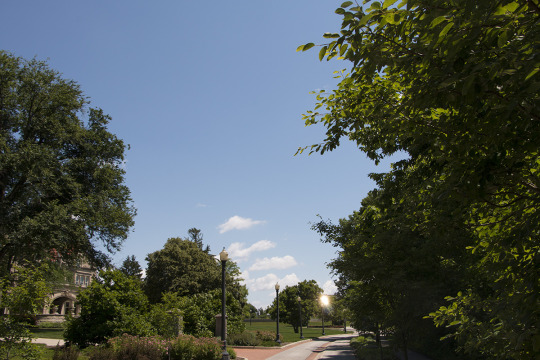
Introduction - Meredith
On Tuesday, June 25, 2019, members of the Muncie Memories team conducted a fieldwalk at Minnetrista, mainly in the Oakhurst section where the Ball Brothers’ homes stand. In the following accounts by Kai, Katie, and Ellie, the reader will notice the use of words such as “beautiful,” “magical,” and “peaceful.” Minnetrista is indeed a world set apart. The significance of which is not lost on this writer.
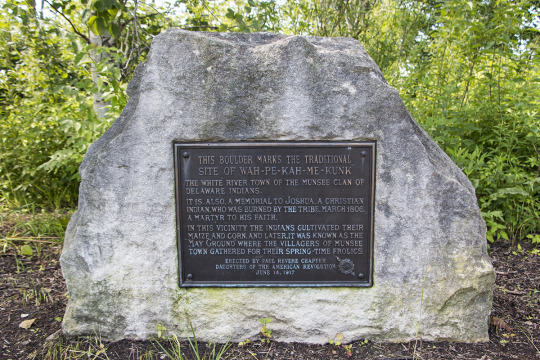
Following the discovery of natural gas in the midwest, the Ball family decided to open a branch of its Ball Brothers Glass Company located in Buffalo, NY in a midwest city that had access to this new cheap fuel source. After considering such places and Findlay and Bowling Green, OH, Frank Ball was invited to tour Muncie by James Boyce, a Muncie industrialist. At the visit with Boyce and the “Citizens Committee,” Frank was offered land southeast of Muncie provided by the “Heekin syndicate” and other incentives. Taking the offer, the Ball Brothers Glass Company started construction in Muncie during the summer of 1887.
During the period from 1888 - 1897, each of the Ball Brothers (Frank Clayton Ball, Edmund Burke Ball, Lucius Lorenzo Ball, William Charles Ball, and George Alexander Ball) relocated in Muncie. In 1894, Frank, E.B., and George purchased 30 acres of land above the White River. This property was christened Minnetrista. This name, a neologism, was made by combining the Sioux word “mna,” meaning water, and the English word “tryst,” meaning for the Balls, a gathering place. Here, the brothers built their homes, their impressive mansions.
Four of the five Ball homes are listed in the Indiana Historic Sites and Structures Inventory for their “outstanding” representations of each of their architectural styles. Each of the homes reflects the individuality of each brother, with styles spanning Tudor Revival, Shingle Style, Colonial Revival, and Late Victorian.
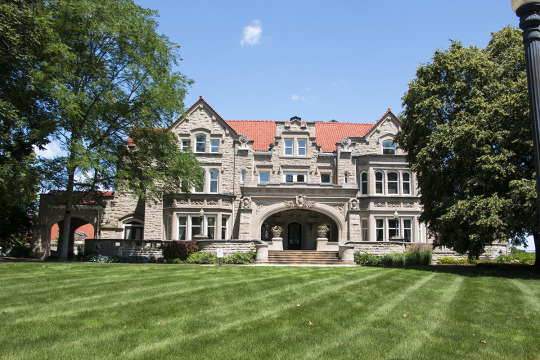
Now, Minnetrista comprises the historical district with the Ball brothers’ homes, a cultural center, and a nature area. At the suggestion of Margaret Ball Petty, daughter of Frank C. Ball, to build a museum in Muncie, the project developed into the Minnetrista Cultural Center. The aim of the Center is to preserve the cultural heritage of the region.
For more thorough information on Minnetrista, visit the Historic Muncie: Preserving Middletown’s Neighborhoods site, which provides an in-depth account of its construction.
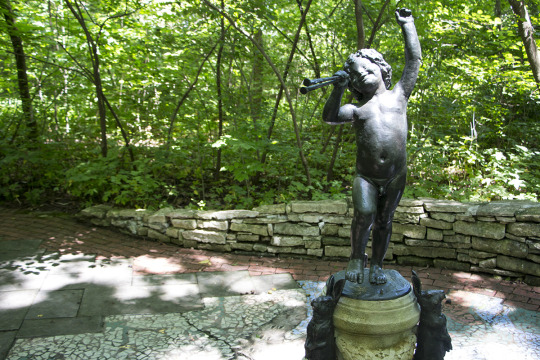
Tranquil Walk - Kai
Walking through Minnetrista, I found myself intoxicated with the beautiful sounds of nature paired with earnest footsteps. As I explored the trails, I enjoyed the exterior architecture of the various Ball Brother houses. I felt as if I had stepped out of the Muncie I had always attached to its name. “Minnetrista” even sounds like a fairytale! I felt like a kid again when the only outside sound other than invisible animals were cars driving by in the distance.
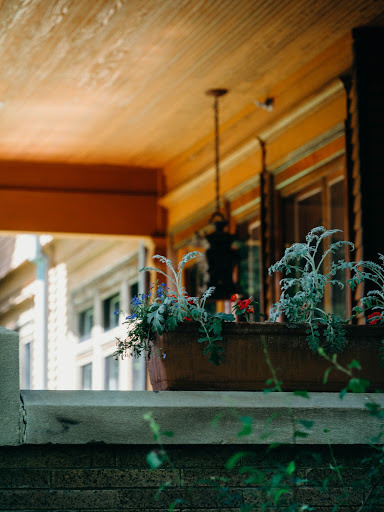
Each house was vastly different than the next, despite this, each had a familiar quality. I felt as if I could just walk in and make myself at home. There was not much of a way to peer into the houses, but the many windows implied that the natural lighting poured into the old mansions. Due to the degree of care still being put into the appearance of these buildings, it is very possible to imagine the rich activity the once occurred here. I feel as though the photographs I captured could not attempt to do Minnetrista justice. This type of atmosphere demanded the intentionality and deliberate attention of a painting. This environment felt like a rural masterpiece.


A Stroll Down Minnetrista Boulevard - Katie
Minnetrista is filled with breathtaking scenery. For our field trip, we focused on the historical homes of the Ball family. While traveling down Minnetrista Boulevard, the homes we encountered were architectural marvels. It was clear to see that no expense was withheld in creating these timeless homes. No home was like, with each drawing different inspiration. For example, Maplewood was most likely influenced by classical architecture.
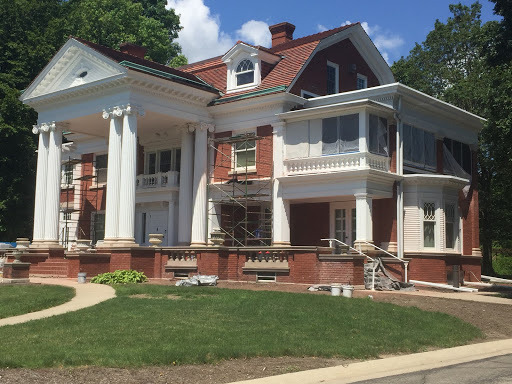
One of the highlights of our exploration was the courtyard behind Oakhurst. Walking through it almost felt magical. The brick paths had mosaic images at crossroads that hinted at the personality of the owner. At one intersection, there was an image of what I could only assume was her family with toys depicted farther to the left. Another intersection showed fairies with butterfly wings. The might be to her loving butterflies. We ended our adventure in the Backyard Garden, enjoying the various fish swim in the pond.
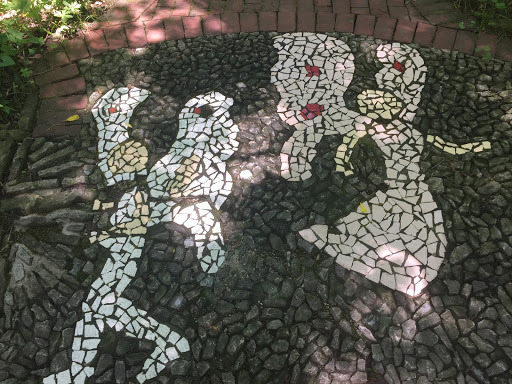
A Path to Where You Want to Lead - Ellie
Between the Oakhurst House and Maplewood House, I discovered an offset path. Once I entered the path, I was astounded. I felt I had entered a different world, like the film Bridge to Terabithia, wherein the main characters discover a path to the magical world of Terabithia. I saw the trees grow tall, covering the sunny sky enough to create a balance of light and dark, allowing an enchanting and mesmerizing forest path scene. I could hear the frequent chirping from the birds in the trees and buzzing of insects as I stood with eyes closed in the middle of the path. I became intoxicated with sound and the lovely nature visuals surrounding me. I even sat down to try to discover more sounds and sites that I may be missing from being indoors all the time. I detected a silvery spider web hanging from a branch and black dragonflies flying in front of me. It was an enjoyable experience as I kept walking down the path, wondering what kind of scenery I would discover at the end. At the end of the path, I saw a beautiful bright garden beside a stone path with a wooden pergola covering on top. I even noticed a cute black bench under the pergola. It looked like a lovely spot to sit and read. It was a breathtaking sight as I could imagine a situation in which I can peacefully sit and go on many book adventures.
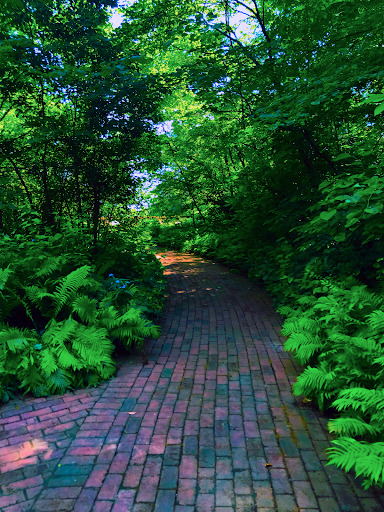
After I left the garden, I learned the offset path is called “Aunt Emma’s Path” from a small sign at the exit of the path. This path was created and named “Aunt Emma’s Path” because of Aunt Emma, who lived in the Maplewood House and would go on walks to visit Frances. The sign also asked, “if you could build a path to visit anyone, anywhere, who would you visit?” It made me think about what I had experienced earlier on the path. The path leads me to a magical world where I could sit and peacefully read and go on book adventures, while it was a path to a friend of Aunt Emma. Even though my path is not used to meet another person at the end, I felt like the path I took helped me unearth who I am and reconnected me to senses of adventure and imagination.

0 notes
Text
Fieldwalk at Beech Grove Cemetery

Introduction - Meredith
On Wednesday, June 19, 2019, we took a trip to Beech Grove Cemetery here in Muncie. During this trip we learned about the history of the cemetery, visited some of the prominent graves, met some folks, and made some audio and video recordings. One of the folks we met was Dave Taylor, one of the cemetery’s board members! He pointed out the grave of Benjamin Cohen to us, tucked away in the Jewish section, telling us that Cohen had been a counselor to FDR on the New Deal! Tina Sulfridge, the Office Manager, was also such a great help as well. She showed us some maps, gave us a tour of the building, and provided us with useful information about the grounds and its history.
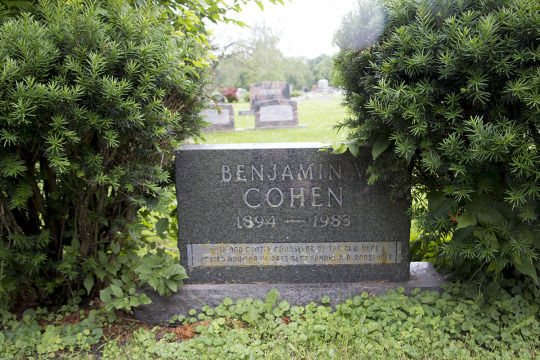
Located at 1400 Kilgore Ave, Beech Grove Cemetery claims Delaware County’s largest historic landmark. Though its official history begins in 1841, it has a prehistory. In “A History of Beech Grove Cemetery” by Dolores Black Rench, she writes that the Delaware Native Americans had “chosen a portion of [the site along White River] for a sacred burial ground.” (You can download a pdf of the complete history of purchase the Beech Grove Cemetery Records book in the office.) This area came to be known as Beech Knoll. Later on, when white settlers arrived, the village was known as Munceytown, and picnics, gatherings, and political rallies were held there.
Before Beech Grove Cemetery was established, there were two public designated burial grounds in downtown Muncie:
1. On the northside of East Main St, east of Beacon St

2. On the northside of Adams St, west of Franklin

2.5. Three boxes of unidentified bones were found when excavating ground for a basement for Friends Memorial Church at the northeast corner of Adams and Cherry. They were reinterred at Beech Grove in October 1906 and May 1907
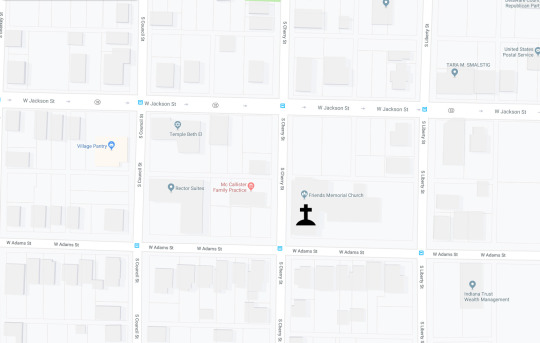
On December 17, 1841, Samuel W. Harlan, John Jack, and James Hodge (trustees for Munceytown) purchased 1.5 acres from Moses and Nancy Eby. This acreage was the first part of Beech Grove Cemetery and is referred to as the Old Ground. Over the years, more and more acreage was leased, deeded, and purchased, expanding the cemetery’s land. One of the most significant additions was that of John Moore’s 51 acre farm (also known as the John Galbraith farm) on April 8, 1902.

Interestingly enough, Goldsmith Gilbert, his wife, and family (arguably the founders of Muncie) are buried in the Old Part, or, rather, had been moved there from their plots at their family home. There are some death date mix ups though for Goldsmith’s wife Mary! Another fun fact, Gilbert and Mary’s daughter Mary Jane was the first white girl born in Muncie and Delaware County. Interesting! Their family home, a log cabin, was located at Walnut and Wysor, not too far from Muncie Memories HQ! Same goes for their original burial grounds too...

How we memorialize - Jenna
Overall, the experience at Beech Grove was educational and I enjoyed the hours we were able to spend exploring. Beech Grove Cemetery is full of hidden beauty, from stained glass windows in mausoleums to Crazy Circle, which should be more aptly named Chaotic Circle. From above, Crazy Circle is a beautiful arrangement of headstones to create a spiral form. On the ground level, it’s many graves piled into a section to help achieve this effect. While walking through it, I wondered why a cemetery would go to such great lengths to achieve this, and did the people buying those lots know they would be part of this “fun fact” for the cemetery?
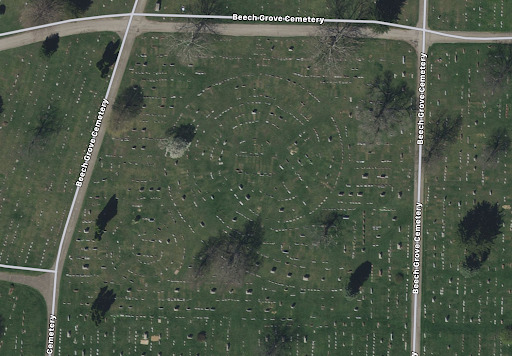
Aerial image of crazy circle.
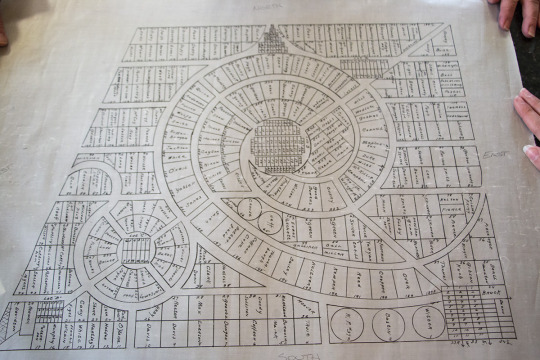
Plans of crazy circle.

In crazy circle
Like many places, Beech Grove Cemetery has hidden beauty and plenty of history. I believe my favorite part of this experience was discovering the unique characteristics that belonged here. Many of the gravesites were delicately decorated and many of them helped you learn more about the person who had passed. Leaving flowers is always nice for a loved one who has passed, but leaving memories and items the deceased cared about when they were living seems more personable to me.
One gravesite in particular caught my eye. It was for a young man who was only 20 years old. His friends and family left him a memorial with a skateboard, a half empty bottle of whiskey, and other trinkets that represent him. I find creating a memorial full of personal joys and belongings allows you to better understand the person who has passed and creates a connection between the individuals grieving, missing, or celebrating that person.
Exploring Beech Grove was a great introduction to learning about the history of Muncie, and I hope we go back to discover parts of the cemetery that we did not visit the first time!
Architecture and Communities - Kitty
Beech Grove is laid out in two discrete sections: the newer section is across the tracks, reached by way of the underpass and then the rest of the cemetery. The older section was laid out to be enjoyed more like a local park in today’s time; this was not uncommon for the era in which the cemetery was founded. It wasn’t until more recently that the newer grave plot system was employed, allowing more bodies to be buried instead of focusing on scenery, which the landscape expert O.W. Crabbs had in the past.

Along with the many curious layouts of the cemetery, it is interesting to note that the cemetery itself is around 120 acres. This large area contains an array of different communities of Muncie with differing grave markers. For example while most mausoleums are found along Mausoleum Row, it is not uncommon to see them scattered throughout older parts of the cemetery. Obelisks stand next to wooden crosses or field stones. Walking through the cemetery, it felt as though the Muncie community was holding itself together even in death. The rich standing next to the poor in unity.

As Beech Grove has changed over the years, so have the community locations. While the newer sections of the cemetery integrate all of the communities of Muncie, the older part keeps separate communities apart, making them radically visible. There is the Jewish section, the African American section, which is labeled Colored for historical reasons, the Armed Forces, and Baby grave sections.
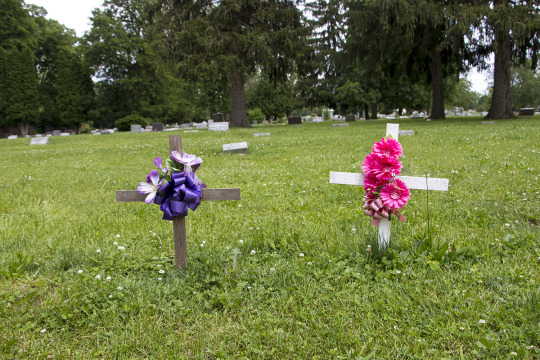
Exploring Beech Grove allowed us to immerse ourselves in Muncie’s unique past to understand its present better. We are happy with what we have learned so far, but we want to know more. What do YOU know about Beech Grove and the people that are there? We would love to hear from you!
Send us an email! [email protected] Drop us a line on Facebook, Instagram, and Twitter!
0 notes